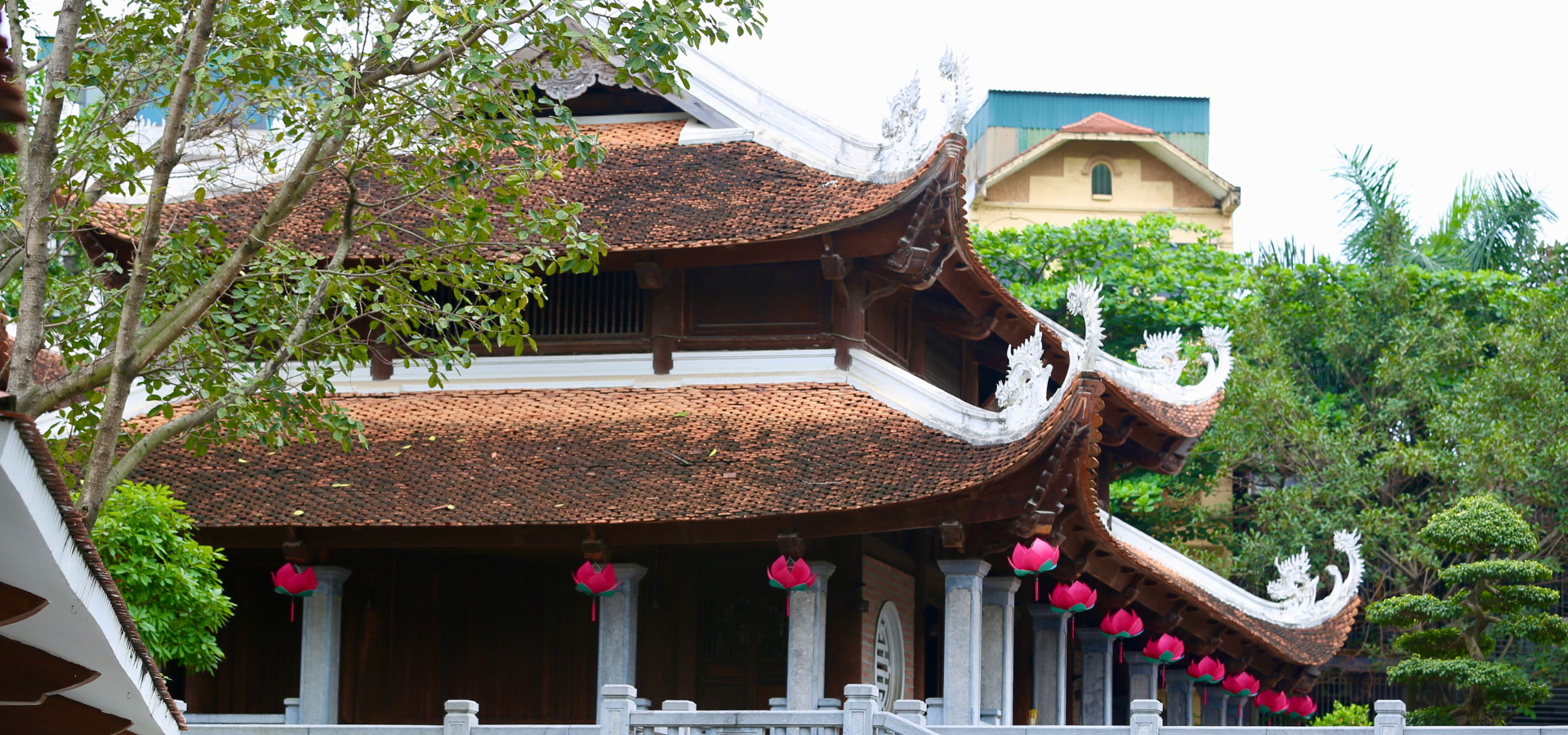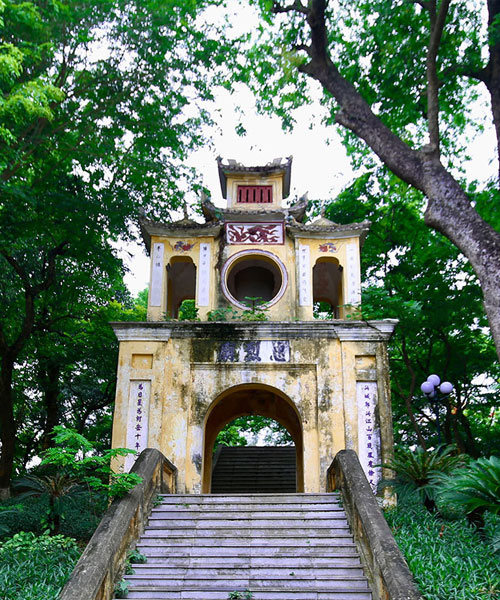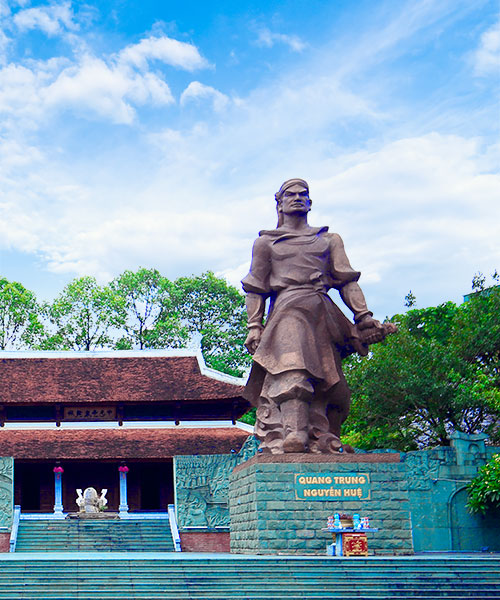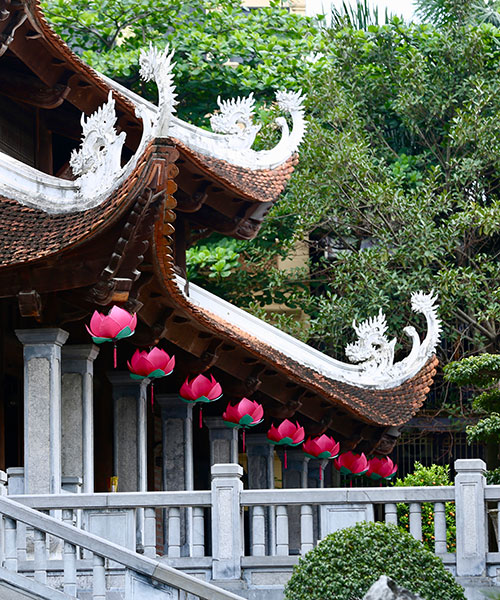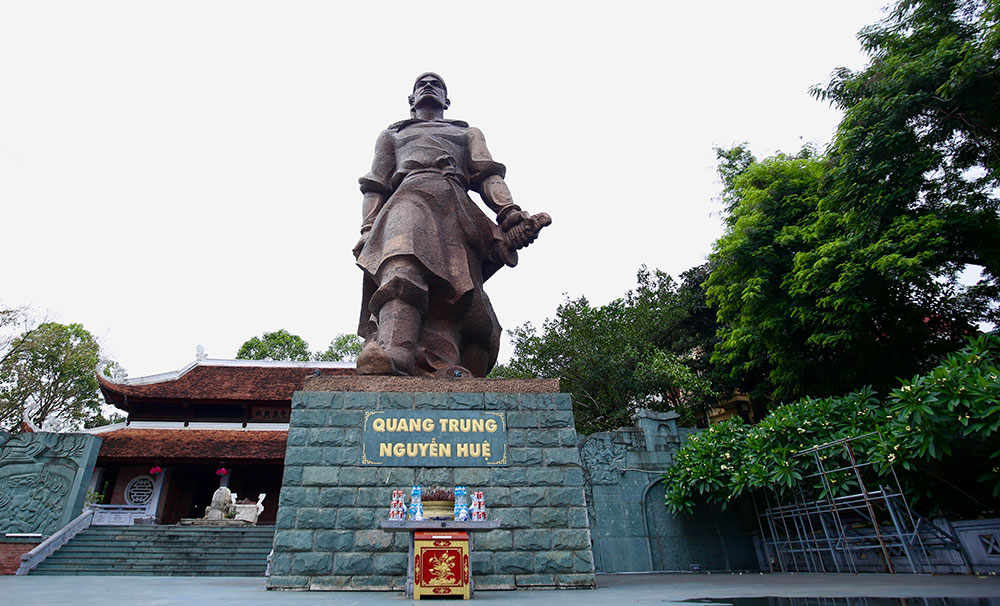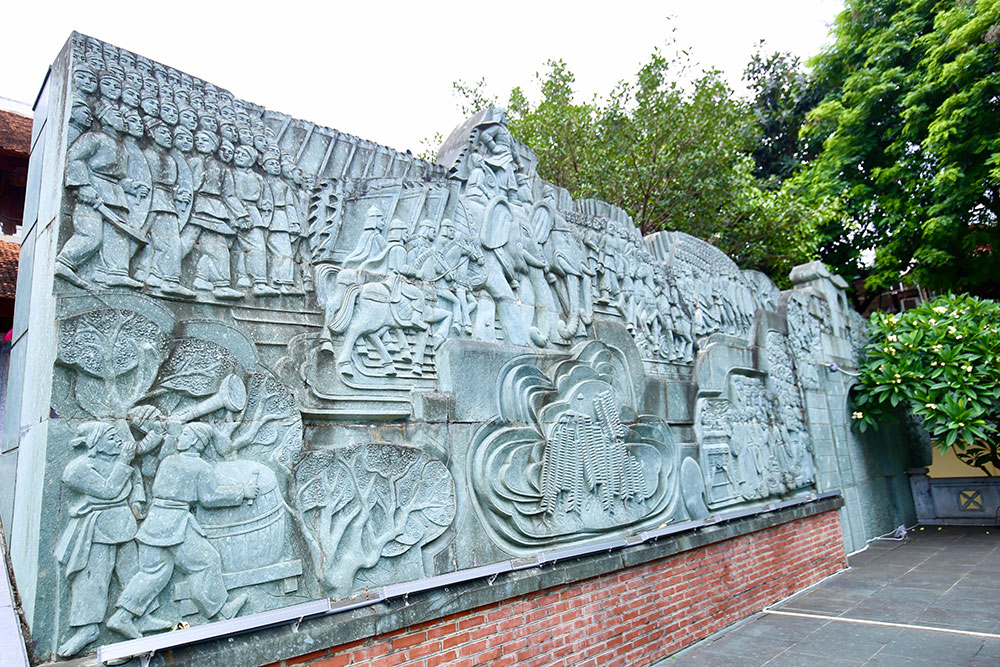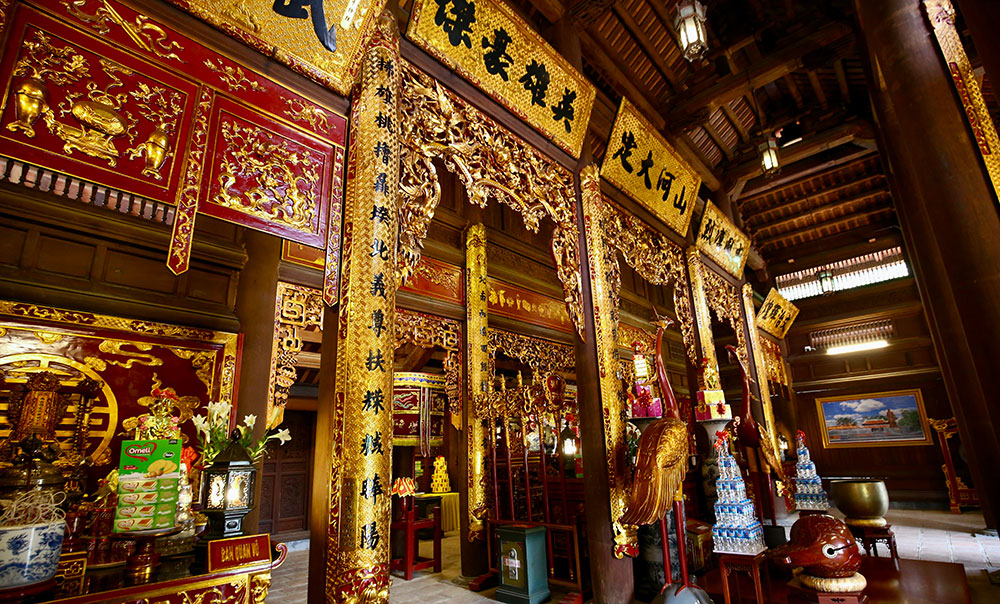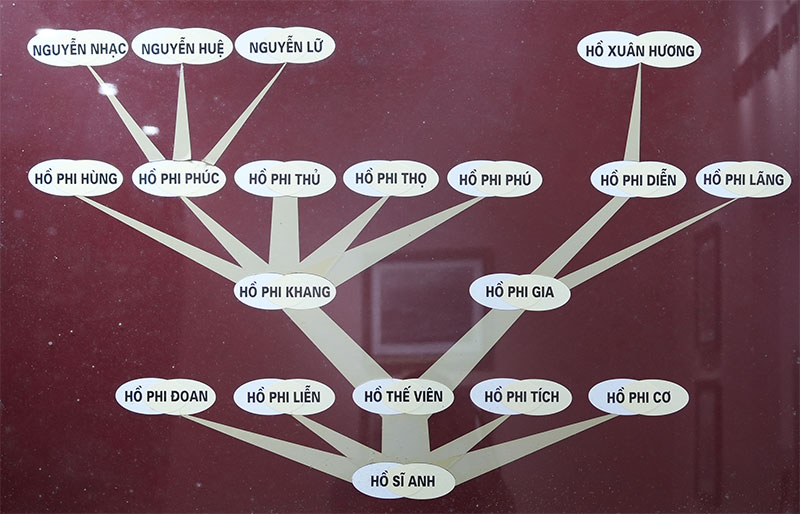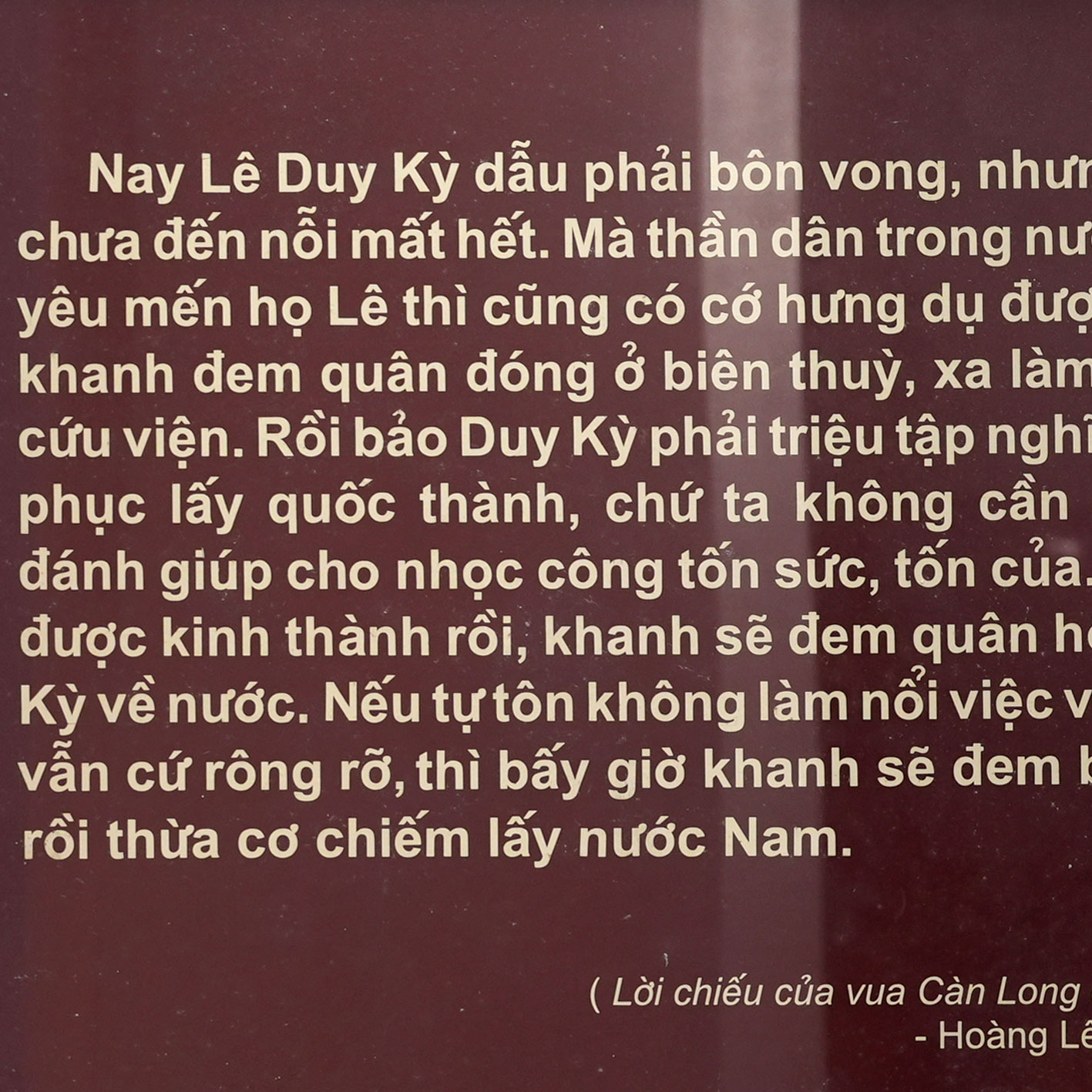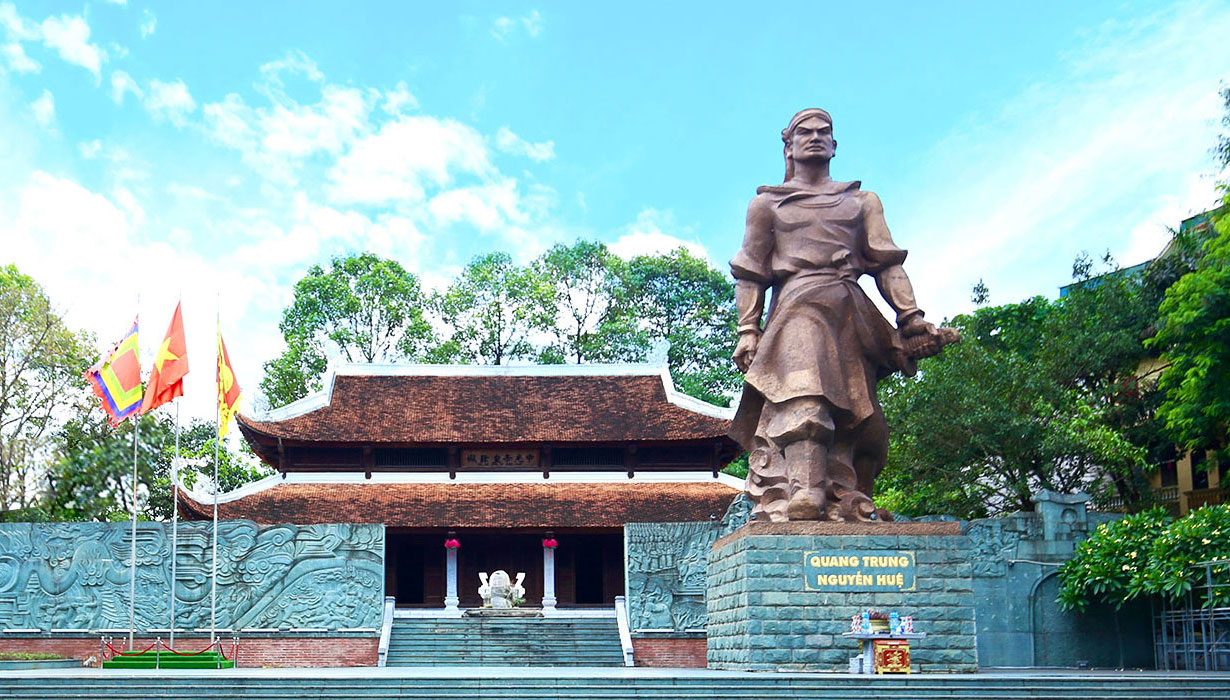NATIONAL SPECIAL RELIC SITE
DONG DA MOUND
Dong Da Mound is located in Quang Trung ward, Dong Da district, Hanoi city. According to old historical records and the recollections of the elders in Thinh Quang village, Dong Da Mound was formerly located in Khuong Thuong village, Quang Duc district, Thuan Thien Prefecture. This is also one of the battlefields where the great defeat of the Qing army by Emperor Quang Trung took place in the spring of “Kỷ Dậu” year (1789).
IntroductionTYPICAL MONUMENTS
EXHIBITION
Painting of the Tay Son family’s genealogy chart
Mr. Ho Phi Phuc gave birth to three children, Nguyen Nhac, Nguyen Hue, and Nguyen Lu
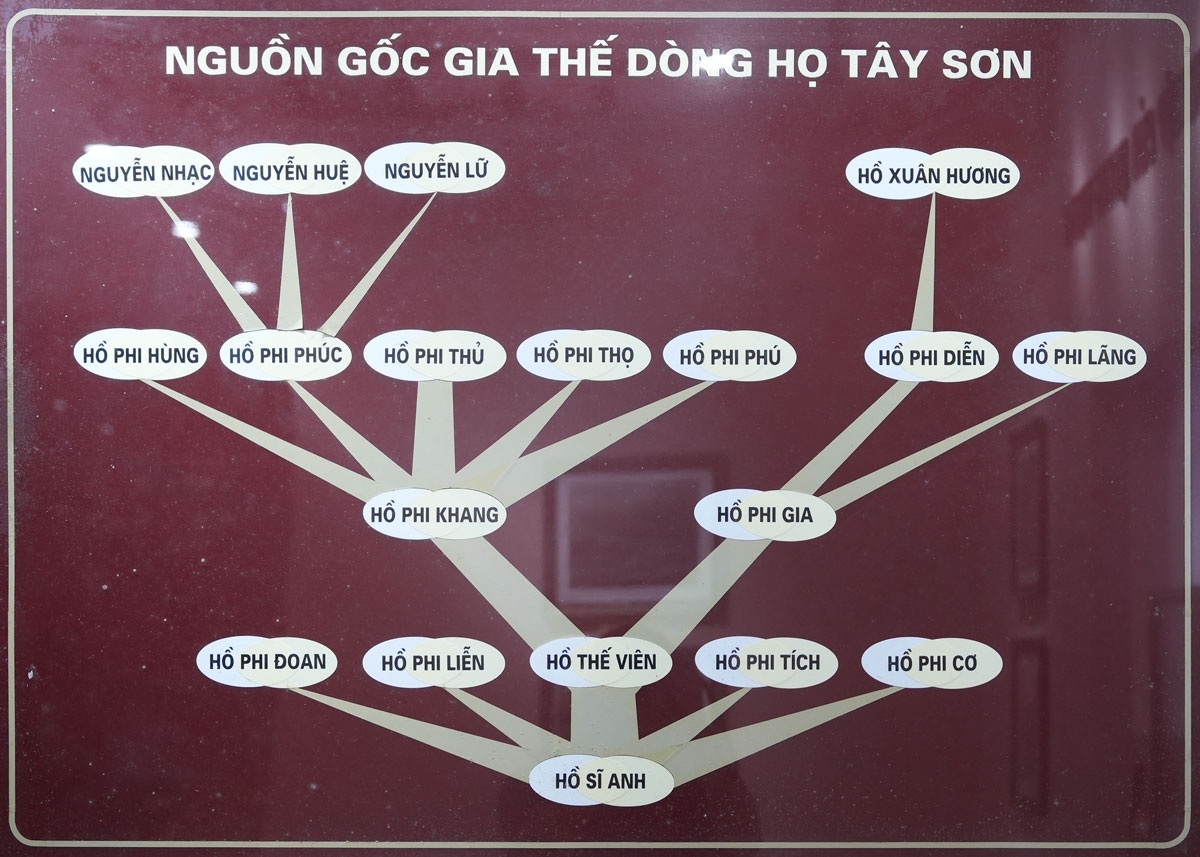
The Tay Son family was originally the Ho family, they settled in NGHE AN. The 4th generation ancestor of Quang Trung – Nguyen Hue was Ho Si Anh in Thai Lao village, Hung Nguyen district, Nghe An province, who was captured by Lord Nguyen and brought to Dang Trong to explore the Upper Tay Son region. The descendant of Mr. Ho Si Anh in Binh Dinh is Mr. Ho Phi Phuc, who was ambitious, wise, and clever, both farming and trading betel and areca, and married Mrs. Nguyen Thi Dong, who is the only daughter of a rich man in Kien Thanh hamlet, Tuy Vien district, Quy Nhon district (now Phu Phong town, Tay Son district, Binh Dinh province). In order for their son to inherit the property and take care of the incense sticks for his mother’s side, Mr. and Mrs. Ho Phi Phuc changed the family names of their three children to their mother’s family name, Nguyen family; Nguyen Nhac, Nguyen Hue and Nguyen Lu
Materials: Tay Son Museum – Binh Dinh
Painting of the Tay Son family’s genealogy chart
Painting of Elephant training ground

Painting of Elephant training ground: Where female general Bui Thi Xuan used to practice fighting elephants
Painting of Elephant training ground
Photos of Dong Da Mound Festival in years
These are some pictures of the Dong Da Mound Festival held on the 5th day of Tet every year to preserve and promote the cultural spiritual values of the nation, continue the patriotic tradition, express deep gratitude to the generations who have sacrificed for the independence and freedom of the Fatherland; affirm the position, great stature, and great historical value of the Ngoc Hoi – Dong Da victory in the history of the struggle to build and defend the country of the Vietnamese people.













Photos of Dong Da Mound Festival in years
An Khe Truong painting
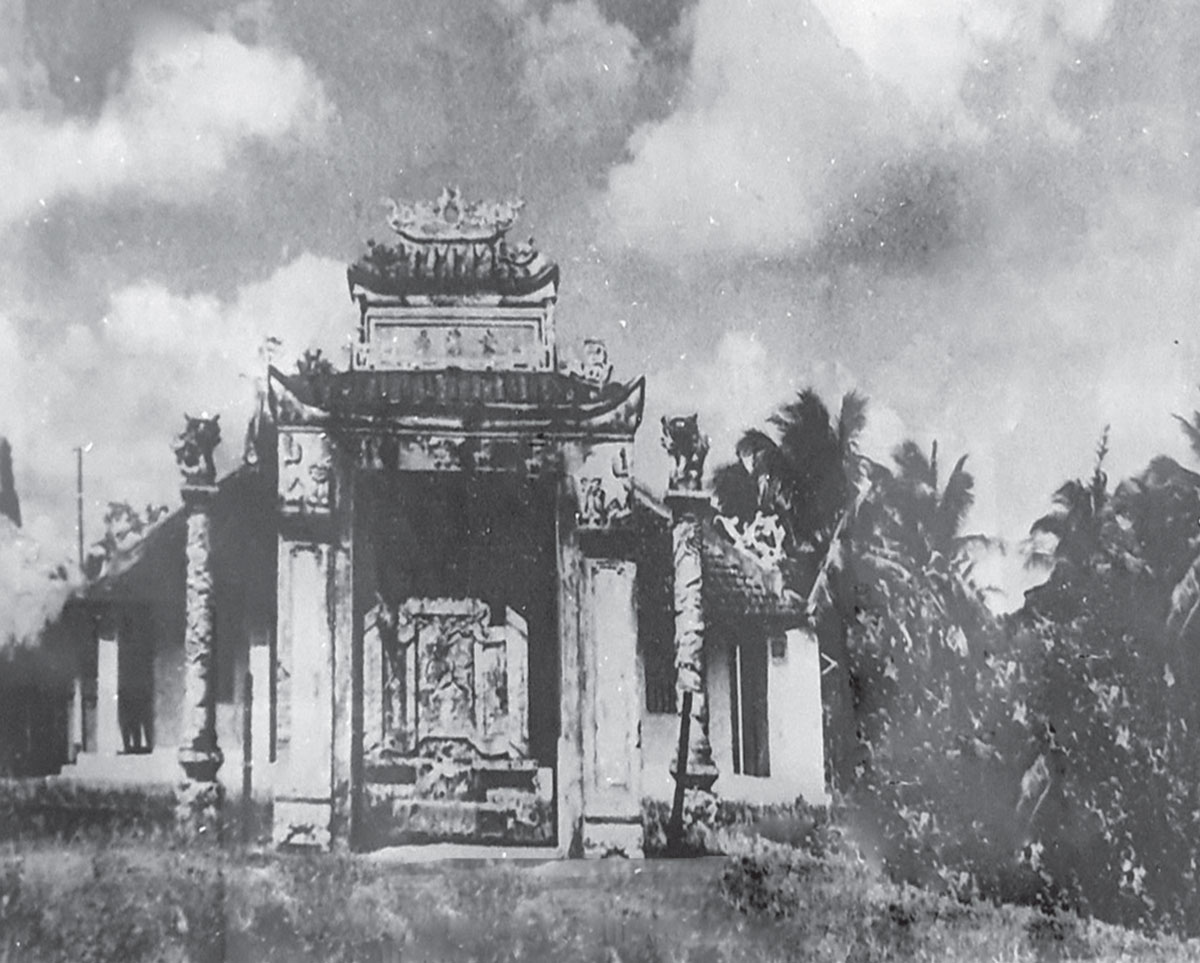
An Khe Truong painting: One of the first bases of the Tay Son insurgent army
An Khe Truong painting
King Qianlong’s edict to Ton Si Nghi
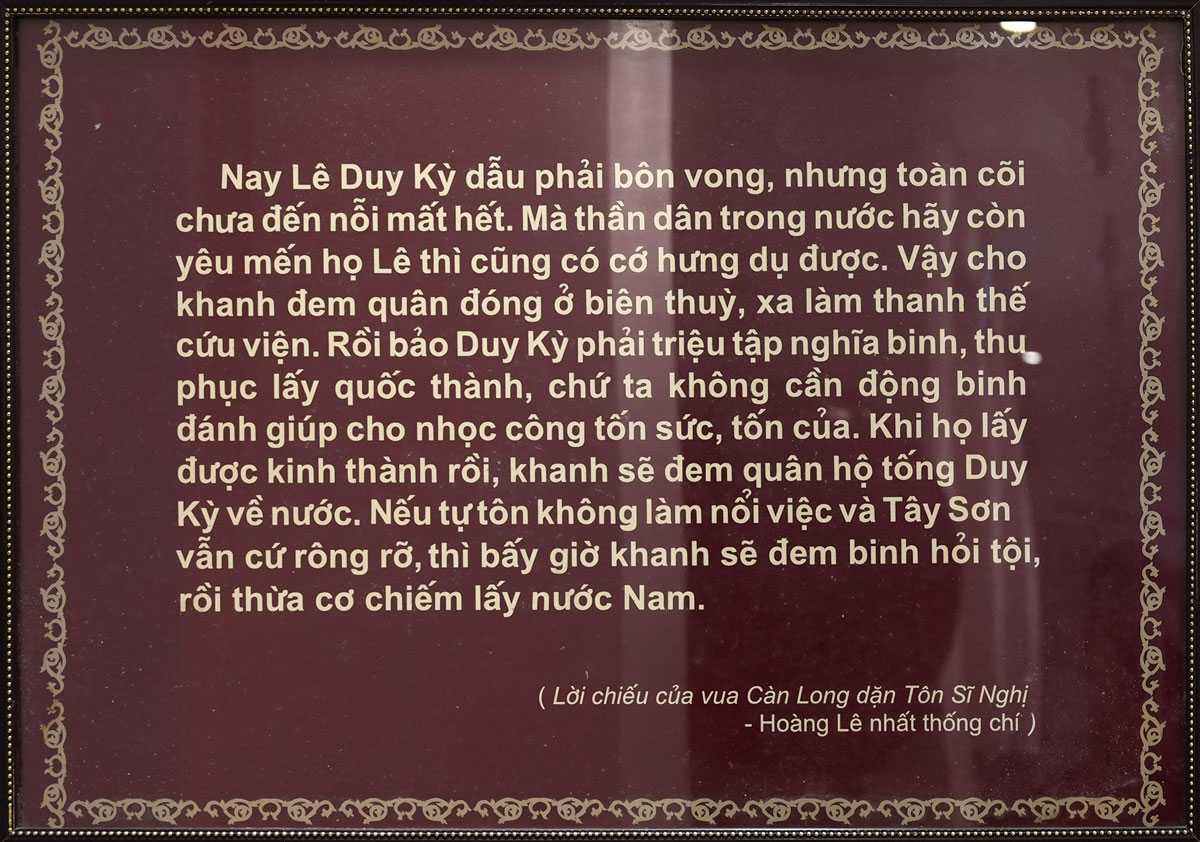
At the end of the year Mau Than 1788, taking advantage of King Le Chieu Thong’s act of “rước voi về dày mả tổ” (act of those who betray their country and their own people), King Qianlong issued an edict directly setting out a strategic direction for Ton Si Nghi to thoroughly take advantage of the contradictions in our country to carry out his ambition of invasion “Now, although Le Duy Ky has to go into exile, his entire family is not yet lost. As long as the people in the country still love the Le family, there is still a reason to prevail. So let You station troops at the border and far away to create a reputation for relief. Then told Duy Ky to summon the insurgents and conquer the capital city, but we don’t need to mobilize soldiers to help with the hard work, effort, and money. When they take the capital, You will bring troops to escort Duy Ky back to the country. If self-respect cannot do the job and the Tay Son is still arrogant, then You will bring troops and take the opportunity to take over the Southern country and bring soldiers to question the crime”
Materials: King Qianlong’s edict to Ton Si Nghi – Hoang Le Nhat Thong Chi
King Qianlong’s edict to Ton Si Nghi
Diagram of Phuong Hoang Trung Do citadel
During his military marches from Phu Xuan to the North, Nguyen Hue quickly realized that Bac Ha (North of Dai Viet country, from the Gianh River border line) was a difficult place to govern, prone to incidents, and too far from Phu Xuan to Thang Long. Therefore, he had the intention of establishing a new capital closer to Bac Ha. The place Nguyen Hue chose was Nghe An. Nghe An is the halfway point between Phu Xuan and Thang Long, convenient for travel. Another reason is that Nghe An is Nguyen Hue’s ancestral land. The Nguyen family in Tay Son is originally from the Ho family in Hung Nguyen, Nghe An. Setting up the capital in Nghe An is also easy to win people’s hearts when the people of this country have suffered because of the war and hate both King Le – Lord Trinh in Dang Ngoai and Lord Nguyen in Dang Trong.
After many times choosing land for construction, finally the new citadel of King of Northern Conquering Nguyen Hue – later King Quang Trung, was also started. Phuong Hoang Trung Do, also known as Trung Kinh Phuong Hoang Citadel, was built between Phuong Hoang mountain (ie Dung Quyet mountain) and Ky Lan mountain (ie Meo mountain), in old Yen Truong commune, Chan Loc district (now belongs to Vinh city, Nghe An province). The word “Phượng Hoàng” is the name of a precious bird in legend, also the name of Phượng Hoàng Mountain, and “Trung Do” means the capital in the center of the country.
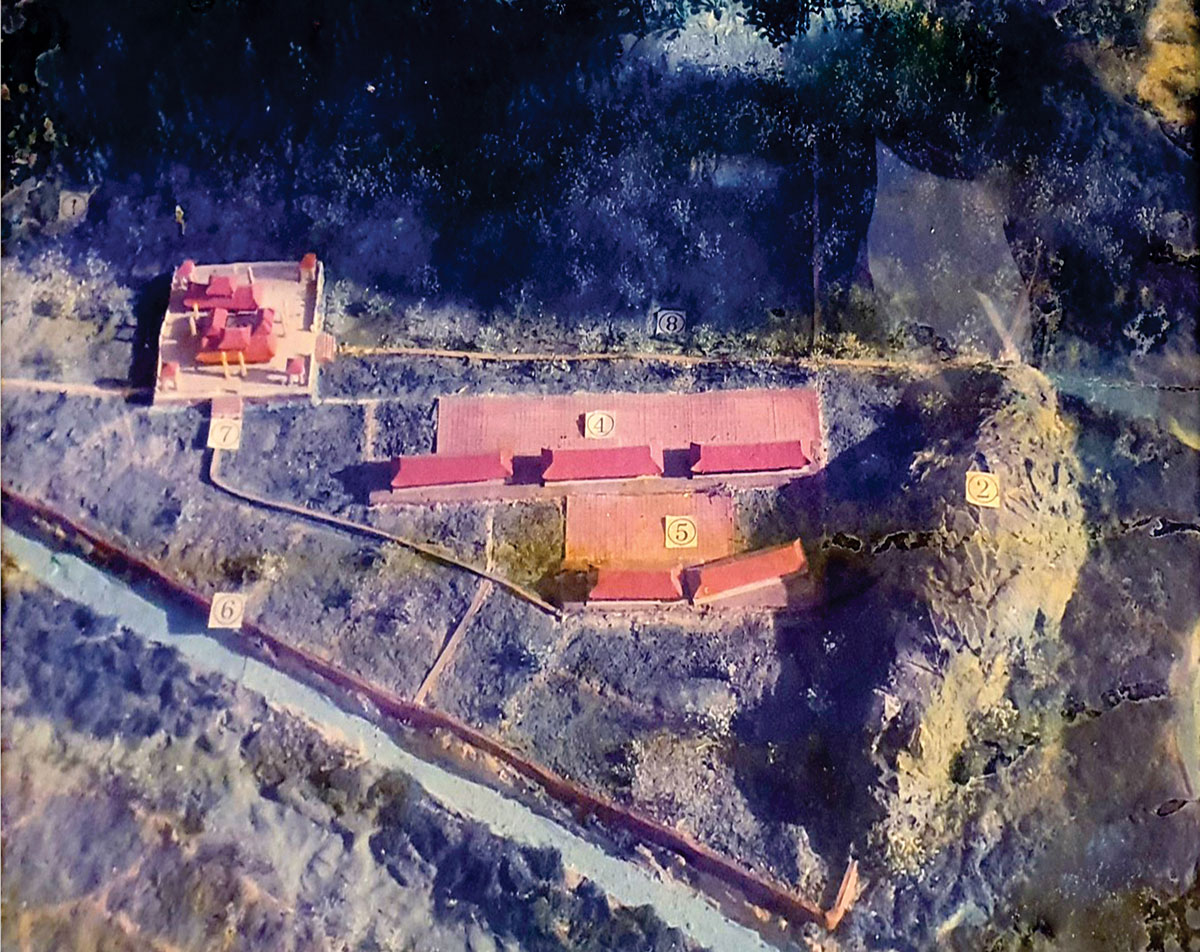
Phuong Hoang Trung Do Citadel was built between 1788 and 1792, depending on the natural terrain. Structurally, the citadel has two rings: the outer citadel and the inner citadel. The outer citadel has a trapezoidal shape, circumference of 2,820m, area of 22ha, wall 3 – 4m high, outside has a moat 3m wide, 3m deep. The citadel wall was built in combination with mountain cliffs as natural ramparts. The outer citadel has 3 gates: Tien gate (South), Ta gate (East) and Huu gate (West). The inner citadel was built of bricks made of terracotta and laterite, with a circumference of nearly 1,680m and a height of 2m; Large doors open to both East and West directions. In the inner citadel, there is a large multi-storied house, 3 floors high, in front there are three-step staircase by laterite, in the back there is a corridor connecting to Thai Hoa Palace used for holding court.
Unfortunately, in September 1792, King Quang Trung suddenly passed away. At that time, Phuong Hoang Trung Do was basically completed, but the King had not yet had time to move the capital from Phu Xuan to Nghe An. King Quang Trung’s successor, Canh Thinh – Nguyen Quang Toan, did not move the capital as advised by his father King Quang Trung but remained based in Phu Xuan. Phuong Hoang Trung Do Citadel was gradually forgotten and became ruins.
Although Phuong Hoang Trung Do was not officially the capital and had a short and unfortunate fate, it was the passion of King Quang Trung and had great significance in a period of Dai Viet’s turbulent history, demonstrating the King Quang Trung’s vision and aspirations for a peaceful, unified, and prosperous country
Materials: Phuong Hoang Trung Do – the connection of the past with the present; New Hanoi Newspaper (December 5, 2019)
Diagram of Phuong Hoang Trung Do citadel
Diagram of Rach Gam – Xoai Mut battle
Resistance against Siamese invaders (1784 – 1785)
Rach Gam – Xoai Mut battle
In 1784, more than 50,000 Siamese troops followed two waterway and road to invade our country and by the end of 1784 they had conquered a few areas in the west of Gia Dinh.
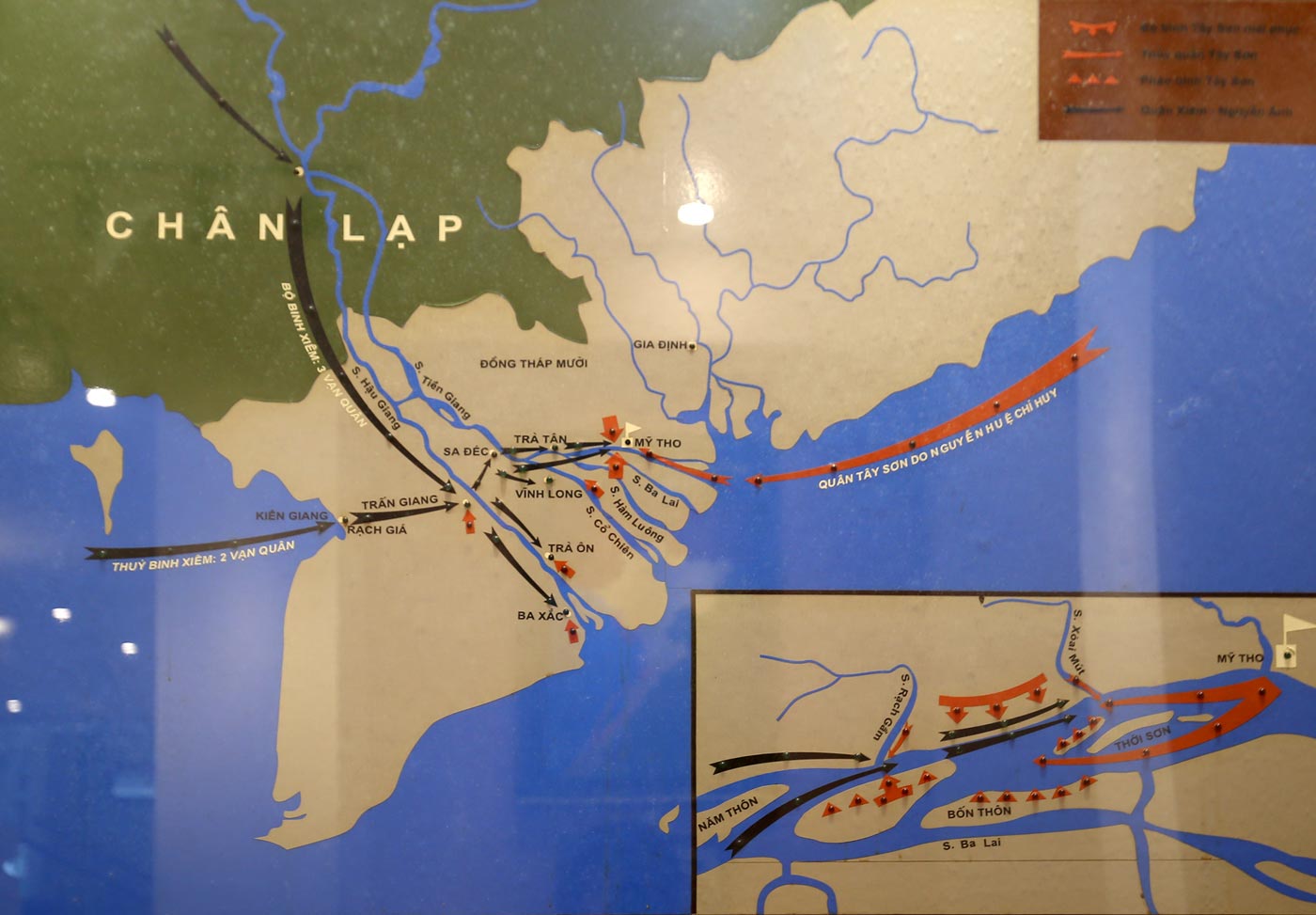
In 1785, Nguyen Hue sent troops to My Tho to attack the Siamese army. He took advantage of the extremely dangerous rising and falling tides in the Rach Gam – Xoai Mut river section as a decisive battle ground for the enemy.
This river section is about six kilometers long and about 1 kilometer wide. In the middle of the river is Thoi Son island, on both sides of the river are dense vegetation, and the north is the vast Dong Thap Muoi. Nguyen Hue decided to arrange a large ambush here:
- The Navy hid their troops deep in the Rach Gam – Xoai Mut river branches and behind the islets.
- Infantry ambushed on the banks and on islands in the middle of the river.
On the night of the 19th and the early morning of January 20, 1785 (Giap Thin year), 50,000 Siamese troops entered the decisive battle with the Tay Son insurgents. When the enemy troops were entered inside the ambush battlefield, the artillery on the boats located on the islands fired extremely fiercely, then the ambush troops on both sides of the river surrounded and flanked, causing all Siamese warships to be sunk here.
The battle of Rach Gam – Xoai Mut is considered an extremely resounding naval battle, it affirmed the great strength of the insurgents and the military genius of Nguyen Hue.
Materials: Vietnam History Book Volume 01 –Hanoi Social Sciences Publishing House 1971
Diagram of Rach Gam – Xoai Mut battle
Painting of Tay Son Brothers’ Temple
The Historical Site of Tay Son Brothers’ Temple is located in Phu Phong town, Tay Son district, Binh Dinh province. The Historical Site has particularly important historical, cultural and scientific significance, associated with the names of three brothers Nguyen Nhac, Nguyen Hue and Nguyen Lu of the Tay Son uprising movement, the Tay Son Dynasty at the end of the 18th century, typified by the national hero Quang Trung.
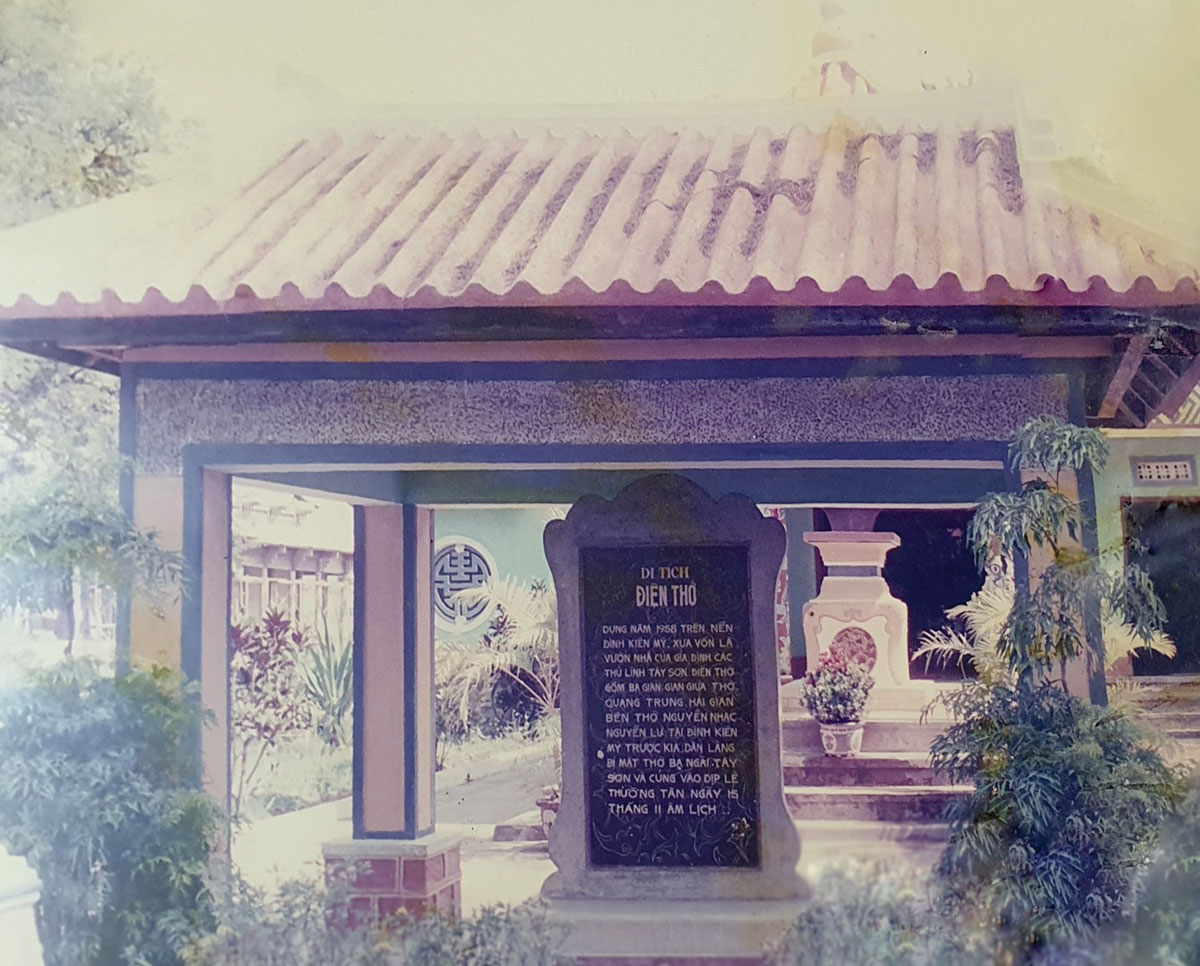
Tay Son Brothers’ Temple was rebuilt in 1998, on the old house of Mr. and Mrs. Ho Phi Phuc to worship the three Tay Son brothers.
Materials: The Historical Site of Tay Son Brothers’ Temple – Historical site of Tay Son Brothers’ Temple – Website of the Ministry of Culture, Sports and Tourism, Department of Cultural Heritage (15/05/2024)
Painting of Tay Son Brothers’ Temple
Painting of Ton Si Nghi retreated
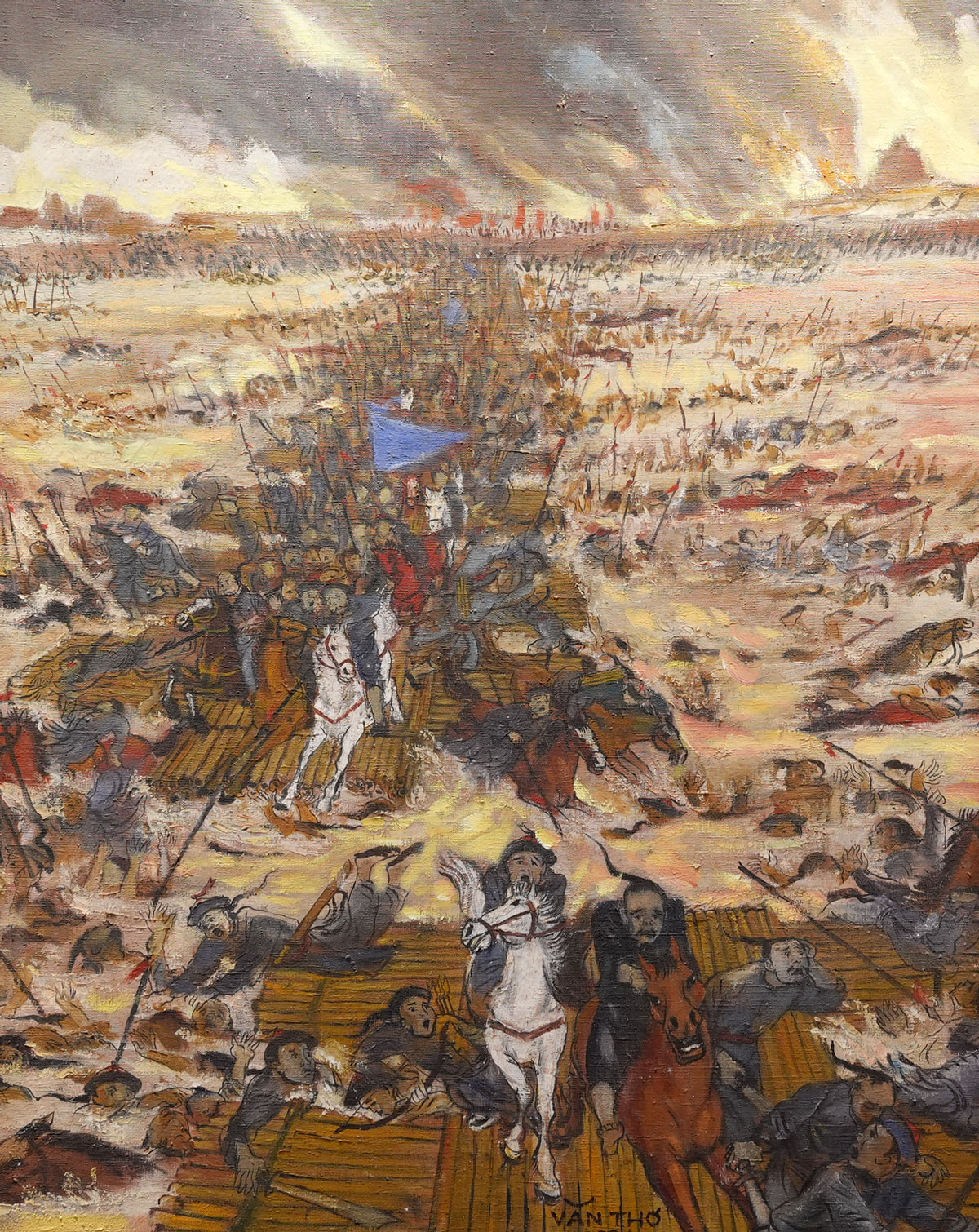
Painting of Ton Si Nghi retreated
Words of filial piety to the generals and soldiers of King Quang Trung (the Proclamation against the Qing)
Words of filial piety to the generals and soldiers of King Quang Trung in Thanh Hoa also expressed his strong determination to defeat foreign invaders to protect national independence
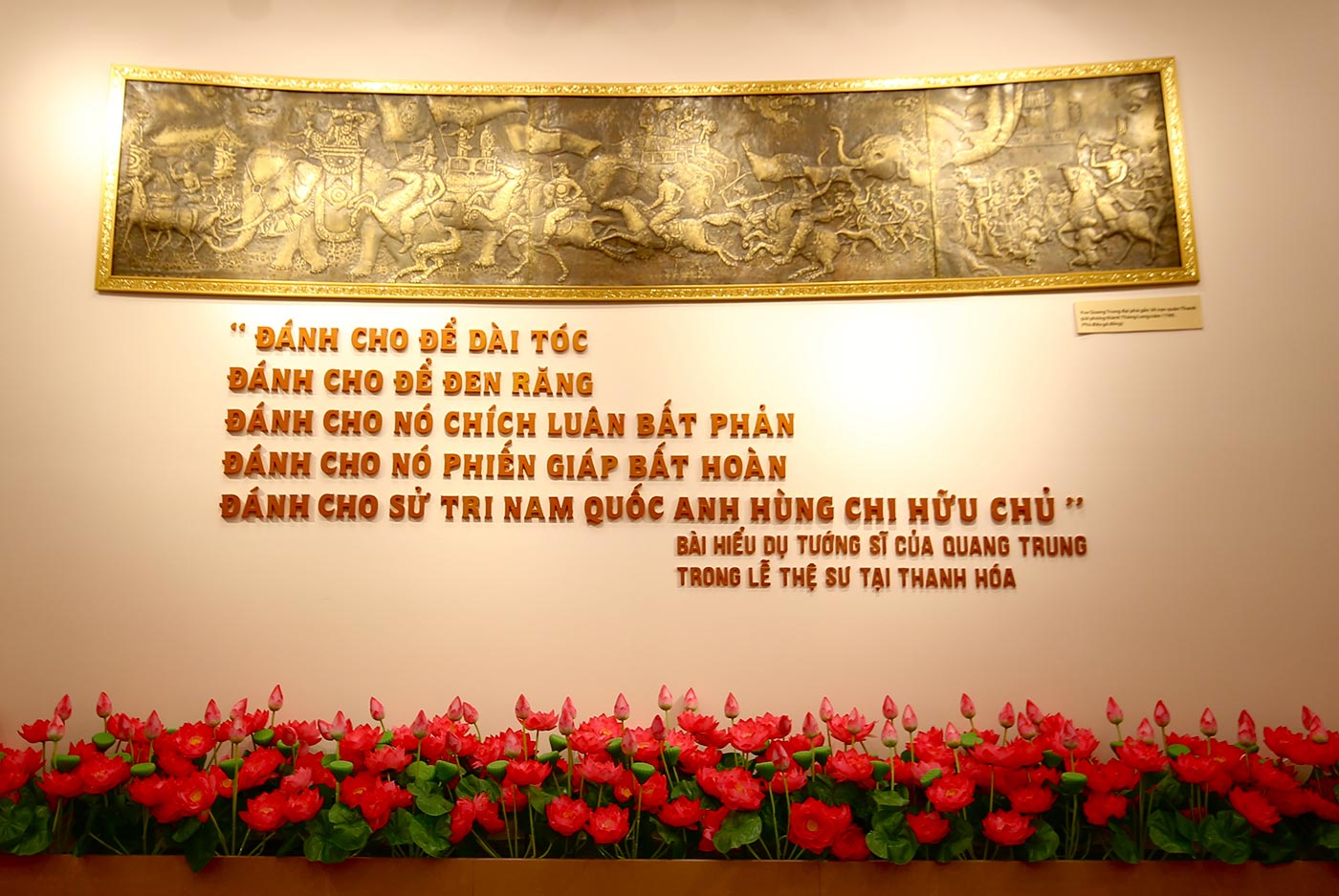
“Fight until their hair grows long
Fight until their teeth turn black
Fight until they never turn back
Fight until they never return with their armor
Fight so that history knows that the Southern nation has a heroic owner”
Materials: Vietnam History Book Volume 01 –Hanoi Social Sciences Publishing House 1971 – p 353



 Tiếng Việt
Tiếng Việt

